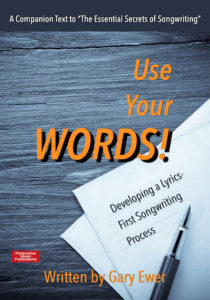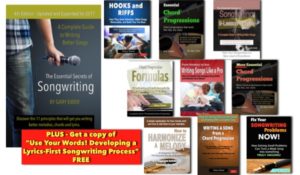When you look at a song’s lyric as displayed on a website or written down on paper, you’re not often aware that the nature of the lyric changes as the song progresses. But it does, and it’s important to get this right if you’re the lyricist.
When we talk about a song’s form, at least in the context of this post, we’re talking about its sections: verse, chorus, bridge, etc. A song makes its strongest impact when it touches the heart of the listener. Every aspect of music bears some responsibility in making that emotional connection, but the nature of the lyric itself is perhaps the most important component in this regard.
 If you’ve always wanted to make lyrics the starting point of your songwriting process, but don’t know how to do that, read “Use Your Words! Developing a Lyrics-First Songwriting Process.” Right now, it’s FREE with your purchase of “The Essential Secrets of Songwriting f10-eBook Bundle”
If you’ve always wanted to make lyrics the starting point of your songwriting process, but don’t know how to do that, read “Use Your Words! Developing a Lyrics-First Songwriting Process.” Right now, it’s FREE with your purchase of “The Essential Secrets of Songwriting f10-eBook Bundle”
We often say that song lyrics are the part that tell the story, but as you know, many song lyrics aren’t specifically story songs. In other words, most of the time we find the story is implied by the lyric.
A good example of what I mean can be seen in Gotye’s song “Somebody That I Used To Know.” It’s not a “first this happened, then that happened” kind of song. In fact, it’s the kind of lyric that would be written after something has happened. We infer the story in retrospect.
But whether the song lyric describes an actual story, or we infer the story, the more important feature is its ebbing and flowing sense of emotional connection. A song lyric that is all emotion all the time can be as ineffective as a lyric that’s devoid of emotion.
In that sense, a good lyric is like an emotion pump: emotion starts low, rises to a peak, then subsides. Then it rises again, peaks, and subsides once more. And it does this several times throughout the song.
How it rises and falls is usually determined by the song’s sections, in the following way. Not all songs will have all of these sections, so for your own songs, remove whichever song sections don’t apply to your song:
- Verse: A typically unemotional description of a situation or circumstance.
- Pre-Chorus: Emotion begins to build. You start to allow the feelings associated with the circumstances you’ve described to come forward.
- Chorus: The lyric uses words that are the kind we’d use when describing our emotions.
- Bridge: The lyric typically goes quickly back and forth between narrative and emotional description.
Because a song usually goes back to the verse after the first chorus, you get a natural up and down of emotional generation:

And of course, there are several variants on that form, all of which serve to increase the emotional ups and downs: a 3rd verse before the bridge, returning to a verse after the bridge, an instrumental solo, etc.
If the song you’ve just written doesn’t seem to be making the requisite connection to the listener, you need to look first at your lyrics, and make sure that they’re doing what they should be doing: providing that necessary up and down of emotion.
Once you’ve done that, take a look the other songwriting elements such as melody and chords. Are they supporting the power and drama of the lyric? Is the instrumentation allowing for that same ebbing and flowing of feelings?
Your song lyric may represent a continuing, seamless storyline that points in one direction, but emotion in the lyric is a different beast altogether. Up and down is the order of the day.
 Written by Gary Ewer. Follow Gary on Twitter
Written by Gary Ewer. Follow Gary on Twitter
If you don’t ha ve a process when you try to write, you’ve just discovered why you find it hard to finish the songs you start. Get “The Essential Secrets of Songwriting” 10-eBook Bundle.
ve a process when you try to write, you’ve just discovered why you find it hard to finish the songs you start. Get “The Essential Secrets of Songwriting” 10-eBook Bundle.











So good. Thanks for this!